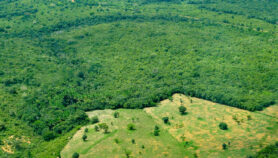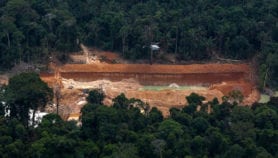Send to a friend
The details you provide on this page will not be used to send unsolicited email, and will not be sold to a 3rd party. See privacy policy.
South Asian countries must be rewarded for afforestation, reforestation and carbon stock growth, say N. H. Ravindranath and Shamama Afreen.
In December 2007, at the UN Framework Convention on Climate Change (UNFCCC) conference in Bali, Indonesia, governments from developed and developing countries alike adopted a 'roadmap' for stepping up efforts to combat climate change.
The roadmap included,among other measures,a commitment to establish policy approaches and incentives for reducing emissions from deforestation and forest degradation (REDD). These are due to be agreed at the UNFCCC climate negotiations in Copenhagen later this year.
Strategies for REDD have been much debated and some developing countries clearly stand to benefit from the proposals. But others, particularly those with low forest cover and low deforestation rates, have little to gain unless negotiators also consider the role of conservation and sustainable forest management.
REDD winners
According to the Intergovernmental Panel on Climate Change (IPCC), the forestry sector contributes about 17 per cent of global greenhouse emissions, making it the second largest source next to energy supply. Estimates put emissions from deforestation in the 1990s at 5.8 gigatonnes of carbon dioxide a year. Deforestation is certainly the largest source of emissions for many developing countries. Research estimates that 12.9 million hectares of tropical forest were lost each year from 2000–2005, mainly through conversion to agricultural land, but also due to expanding settlements and infrastructure.
Brazil, Indonesia, Myanmar, the Democratic Republic of Congo and Zambia occupied the top five positions from 1990–2005, annually deforesting anything from nearly half a million hectares in Zambia to nearly three million hectares in Brazil. And unless action is taken, deforestation is likely to remain high in the tropics over the coming years and decades.
So reducing tropical deforestation is seen as a high-priority way of mitigating potential climate change. And in its 2007 Fourth Assessment Report, the IPCC concluded that it would not cost much to do.
The UNFCCC's vision for REDD is to give developing countries financial incentives to reduce national deforestation rates and associated carbon emissions below a baseline (based either on a historical reference case or future projection). By doing so, REDD should contribute to climate change mitigation and adaptation.
Compensated conservation
But how much individual countries can participate and benefit under proposed REDD mechanisms varies depending on current and projected rates of deforestation and degradation. Countries with widespread deforestation have the most to gain. Others, particularly those with low forest cover and low deforestation rates, have little to gain unless the upcoming Copenhagen climate negotiations also consider the broader provisions in the Bali roadmap — in particular "the role of conservation, sustainable management of forests and enhancement of forest carbon stocks in developing countries".
South Asia, for example, typically has less than 50 per cent forest cover and low deforestation (under two per cent per year), and is unlikely to benefit directly from current proposed REDD mechanisms.
In the past two decades, India has successfully reduced deforestation and largely stabilised its forest area — at around 23 per cent. Its Greening Mission, part of the country's National Climate Change Action Plan, aims to increase India's forest cover — and so its carbon sinks — from about 20 per cent to 33 per cent, through large-scale afforestation, reforestation, agroforestry and shelter belt programmes. India's afforestation programme alone, planting trees over about 1.3 million hectares per year, is already increasing carbon stocks and will create a net sink for the next 25 years.
Bhutan, too, increased its forest area between 2000–2005 — by 0.3 per cent each year— through effective forest conservation and afforestation.
Countries in South Asia need to be rewarded for afforestation, reforestation and carbon stock growth. India, in its proposal to the UNFCCC, has suggested a framework for 'compensatedconservation', arguing that countries maintaining or increasing their forest cover through existing conservation policies and measures should be compensated for their efforts.
The Japan-based Institute for Global Environmental Strategies has similarly suggested that countries with low deforestation rates would benefit from more technical and financial support for forest management from regional and international organisations and mechanisms such as the Food and Agriculture Organization or International Tropical Timber Organization, or REDD mechanisms and carbon markets.
Forest conservation in India and other low deforestation countries comes at a huge cost in terms of forgoing more profitable land uses or harvesting forest products. Rewarding countries that maintain and increase their carbon stocks would be a strong incentive for developing countries to conserve and develop their existing forests.
N. H. Ravindranath and Shamama Afreen are researchers at the Indian Institute of Science, Bangalore, India.













